The first tulips have opened and the gentle greens and pastel colours of early spring have been cut through with their bold show. I can take tulips as bold as you like, provided that in any one vista they complement one another. And I don’t like more than two tulip colours in one view. Few words tonight, but lots and lots of pictures:
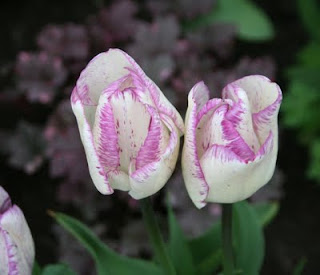 ‘Shirley’ is marvellously tasteful, toning beautifully with Heuchera ‘Midnight Rose’ underneath it. Most of the combinations in this garden are accidental, but I will humbly take full credit for this one
‘Shirley’ is marvellously tasteful, toning beautifully with Heuchera ‘Midnight Rose’ underneath it. Most of the combinations in this garden are accidental, but I will humbly take full credit for this one
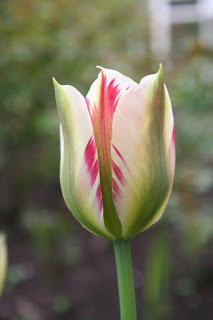 ‘Flaming Spring Green’ is a stunner. I first saw it at Chelsea three years ago and sought it out. These are second year bulbs, left in situ (as mine always are) and have flowered again well. Always a bonus in a tulip.
‘Flaming Spring Green’ is a stunner. I first saw it at Chelsea three years ago and sought it out. These are second year bulbs, left in situ (as mine always are) and have flowered again well. Always a bonus in a tulip.
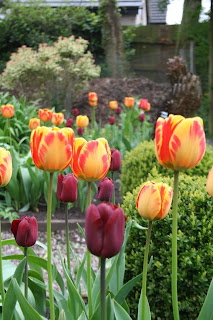
I like to make an early colour statement in the exotic garden – start as I mean to go on. The flamed yellow is Banja Luca. The blood red one is Jan Reus which I picked out at Chelsea last year. A bright red would be a better partner and Jan Reus is a little short as a match, but it’s a pleasingly colourful combination in this hot spot. Will add some Fritillaria imperialis for next year.

I adore this tulip. The white of ‘Carnaval de Nice’ is pure as snow, the red a masterclass in artistic, arterial blood slashes. And it holds its incurved, cupped form for days and days, repelling the weather and opening ever such a little for sunshine. Makes my little heart flutter every time I see it.
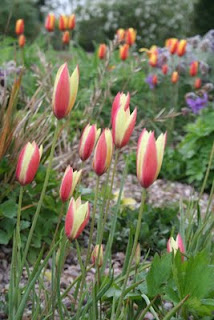 Two species tulips brighten up the scree bed, on different sides. This is Tulipa clusiana var. chrysantha
Two species tulips brighten up the scree bed, on different sides. This is Tulipa clusiana var. chrysantha
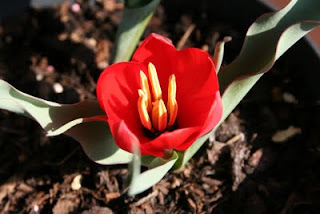
And Tulipa wilsonii. This quick snap doesn’t really do credit to the brilliant intensity of this tiny crimson tulip.

Up in the square borders, where the mounds of herbaceous perennial leaves are pushing through quickly now, ‘Jan Reus’ weaves through in a wide ribbon. This ribbon used to be ‘Angelique’ but I always thought it rather insipid and blowsy. The pale Angeliques are still mostly there, but the deep, warm red makes a much more effective show. For next year I’ll haul out all of the remaining Angeliques, I think and plant – a cream, or a lemon perhaps?

The Berry Border, planted to provide berries and seeds for birds, doesn’t get going early, so I planted these Imperial Fritillaries last autumn to give it an early lift. I am completely bowled over by their unreal form, intense colours and early emergence. Weird smell, which I don’t dislike, but truly stunning.

This orange one has stunning chocolate brown stems above the final whorl of leaves. (Note to self – look up the cv. name)
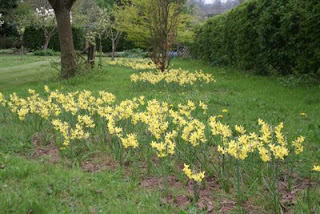
Last year, I took up all the turf under the orchard and sowed a wildflower mix instead. In the autumn, we planted a few hundred Narcissus ‘Hawera’, chosen because it seems to flower late here and is likely to be in flower for the end of April when we open for the NGS. The first ones we planted are in flower. The later batch on the other side are just coming through. I think they will hold on – they stay in flower for a long time.
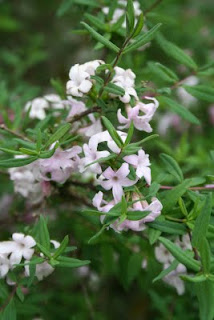
But while the tulips catch the eye all round the garden, these two shrubs catch the nose – their joint scent carrying across the whole garden. This looks like a Daphne, or perhaps a Jasmine, but it’s a shrubby honeysuckle, Lonicera syringantha. Quite a large shrub now, 5ft in all directions and plainly completely hardy, given the past two winters. The scent is stunning.

It’s just a shame perhaps that this Viburnum (probably a x carlessii cultivar) is so close to the Lonicera, above. The scent is even stronger and sweeter, overpowering perhaps by comparison. Anyway, together they perfume the garden beautifully
Finally, folks, a word on peat use following
Mark Diacono’s blog entry and the subsequent discussion. Everything, and I mean everything, on our nursery is grown without peat. I don’t see it as a big deal. There is no sign over the doorway proclaiming that we don’t use peat, just as we don’t have we have a sign declaring that we don’t wear fur coats to work or that we don’t sell plastic flowers. We just don’t and that’s that. We grow from seed, from plugs, from bare roots, from cuttings of all sorts. I’ve yet to find something I want to grow, but can’t because I don’t use peat. Some things don’t grow because I don’t do the right thing to help them along, but that’s all. Plants don’t need peat. Use it if you wish, I’m not telling you what to do. But don’t tell me that this or that can’t be grown without it. You’ll get one of two answers. Either I’ll say ‘Oh yes it can’, or ‘Fine – if it absolutely won’t grow without peat, then I don’t want it’. I don’t think I’m missing anything, in fact, I know I’m not.
 ‘Shirley’ is marvellously tasteful, toning beautifully with Heuchera ‘Midnight Rose’ underneath it. Most of the combinations in this garden are accidental, but I will humbly take full credit for this one
‘Shirley’ is marvellously tasteful, toning beautifully with Heuchera ‘Midnight Rose’ underneath it. Most of the combinations in this garden are accidental, but I will humbly take full credit for this one ‘Flaming Spring Green’ is a stunner. I first saw it at Chelsea three years ago and sought it out. These are second year bulbs, left in situ (as mine always are) and have flowered again well. Always a bonus in a tulip.
‘Flaming Spring Green’ is a stunner. I first saw it at Chelsea three years ago and sought it out. These are second year bulbs, left in situ (as mine always are) and have flowered again well. Always a bonus in a tulip. I like to make an early colour statement in the exotic garden – start as I mean to go on. The flamed yellow is Banja Luca. The blood red one is Jan Reus which I picked out at Chelsea last year. A bright red would be a better partner and Jan Reus is a little short as a match, but it’s a pleasingly colourful combination in this hot spot. Will add some Fritillaria imperialis for next year.
I like to make an early colour statement in the exotic garden – start as I mean to go on. The flamed yellow is Banja Luca. The blood red one is Jan Reus which I picked out at Chelsea last year. A bright red would be a better partner and Jan Reus is a little short as a match, but it’s a pleasingly colourful combination in this hot spot. Will add some Fritillaria imperialis for next year. I adore this tulip. The white of ‘Carnaval de Nice’ is pure as snow, the red a masterclass in artistic, arterial blood slashes. And it holds its incurved, cupped form for days and days, repelling the weather and opening ever such a little for sunshine. Makes my little heart flutter every time I see it.
I adore this tulip. The white of ‘Carnaval de Nice’ is pure as snow, the red a masterclass in artistic, arterial blood slashes. And it holds its incurved, cupped form for days and days, repelling the weather and opening ever such a little for sunshine. Makes my little heart flutter every time I see it. Two species tulips brighten up the scree bed, on different sides. This is Tulipa clusiana var. chrysantha
Two species tulips brighten up the scree bed, on different sides. This is Tulipa clusiana var. chrysantha And Tulipa wilsonii. This quick snap doesn’t really do credit to the brilliant intensity of this tiny crimson tulip.
And Tulipa wilsonii. This quick snap doesn’t really do credit to the brilliant intensity of this tiny crimson tulip. Up in the square borders, where the mounds of herbaceous perennial leaves are pushing through quickly now, ‘Jan Reus’ weaves through in a wide ribbon. This ribbon used to be ‘Angelique’ but I always thought it rather insipid and blowsy. The pale Angeliques are still mostly there, but the deep, warm red makes a much more effective show. For next year I’ll haul out all of the remaining Angeliques, I think and plant – a cream, or a lemon perhaps?
Up in the square borders, where the mounds of herbaceous perennial leaves are pushing through quickly now, ‘Jan Reus’ weaves through in a wide ribbon. This ribbon used to be ‘Angelique’ but I always thought it rather insipid and blowsy. The pale Angeliques are still mostly there, but the deep, warm red makes a much more effective show. For next year I’ll haul out all of the remaining Angeliques, I think and plant – a cream, or a lemon perhaps?

3 Responses to “Tulipmania”
I planted Flaming Spring Green in the ground this year – so good to know it came back for a second year for you.
I do like the orange Imperial Fritillaries – they look quite other worldly for this time of year.
K
Carnival de Nice is my favourite tulip this year too, it has reappeared, which most tulips don't, so must buy more. I do so agree with you about the peat situation, havn't used it for years, don't need to – keep up the good work !
That looks so pretty! I like it..
Thanks for sharing with us..